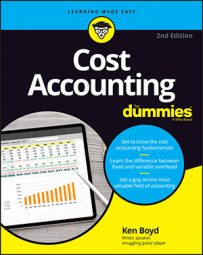In cost accounting, capacity refers to how much you can do, based on the assets (equipment, machinery, vehicles, and so forth) you have. In business, determining your true capacity level is a balancing act. You want to avoid investing too much and then find that the capacity isn’t needed. The money you invest in unused production capacity could be better spent elsewhere.
On the other hand, you want to invest enough to fill every possible customer order. Your realistic capacity is somewhere in the middle. You want the ability to fill orders without biting off more than you can chew.
Two types of capacity focus on customer demand. Normal capacity utilization and master budget capacity utilization are driven by customer orders. Select a capacity method that makes sense to you, and use that as a tool to plan production and spending.
Normal capacity utilization is the level of capacity needed to meet customer demand over several years. Master-budget capacity utilization is the expected level of capacity needed for your current budget. You use both measurements to control costs.
Add the term utilization to the discussion. In this case, utilization means the amount of capacity you need to meet customer demand.
Any available production capacity beyond the customer demand level isn’t needed. You don’t have customers to buy the extra products produced.
Consider whether your business is seasonal. Certain seasons produce more demand for certain product; then, when the season’s over, retailers clear out merchandise. This is the clearance-sale concept. Some smart shoppers always buy at the end of a season. They buy winter coats in April and swim suits in September. Stores are cutting prices to clear inventory that is no longer in season.
A lot is riding on your understanding this issue. You need to crank up production before your busy time of year. You need machinery, materials, and labor to be available during that heavy production time. Consider your cash position. You produce more goods, sell more goods, and collect more cash during your busy season. When things slow down, you produce less, and you need to plan your cash use to get through the slow times.
A two- or three-year period includes the impact of the seasonality of your business each year. If you sell outdoor athletic equipment, you have a busy spring and summer, and maybe a slowdown in winter. If you manufacture outdoor athletic equipment, you have a busy autumn and winter making products for retailers. An analysis over several years may pick up changes in the overall economy. Think about normal capacity as on-average capacity.
A cyclical stock is a term used in the investment business. This type of investment is affected by changes in the overall economy. Cyclical stock prices do well in good times and poorly in bad times. Picture companies that make or sell goods that are discretionary purchases. When the economy goes down, consumers buy fewer luxury items. Sales of expensive clothing, jewelry, and cars generally decline.
Master-budget capacity utilization is the expected level of capacity needed for your current budget. In planning, you make assumptions about costs and sales, and then you use the data to come up with a capacity level of production.
A word of caution: This year’s budget may not reflect the same level of capacity needed over two to three years. Your master-budget capacity may reflect a great current economy and a high level of sales. Normal capacity might reflect an average economy over two to three years. The economy is like a roller coaster; there can be big highs and lows, and the changes can happen quickly. Keep your time period in mind as you make capacity decisions.

